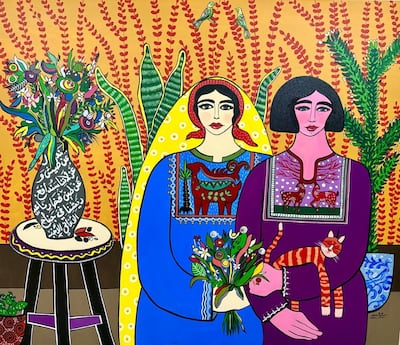Just off Salaam Street, next door to Jerusalem Textiles, a bright painting covers one of Abu Dhabi’s concrete residential buildings. The mural echoes the natural world around it: the blue sky, palm trees, white animals and a yellow calligraphic frame in the centre.
Titled Peace with a Blue Horizon, it is a token of calm in what has been a horrific year for the work's maker, Mohammed Al-Hawajri, and his wife and four children.
The family lived in a three-storey house in Bureij, in central Gaza, where Al-Hawajri and his wife Dina Mattar were well-respected arts community members. But in October last year, their home was hit by an air strike, sending them on a journey of displacement and loss.
“My house is destroyed, my studio is destroyed, my artwork is destroyed, everything is destroyed,” Al-Hawajri tells The National. “In the beginning, I was very sad about this. But when I see the people die, I say, OK, maybe one day I can come to build my house again. Because the people who have been killed in this situation – my friends, my family, I have lost more than 50 people from my family – will still be dead.”
The family fled the house, taking nothing but their passports and essential papers. They moved to Al-Hawajri's sister’s home in Nuseirat, near Al Bureij camp, but there they were again caught in an air strike. Al-Hawajri recalls being unable to recognise his children or his wife because they were covered in dust. He only knew them by their voices.

His children, though terrified, were safe. However, others, including his uncle, were not as lucky. Later, the area was bombed again and he lost his cousin, his cousin’s wife, their children and all nine of their grandchildren.
“After that I said to myself, I have to find a way to get out of Gaza because I cannot stay,” he says. "I am sure that we will die.”
Al-Hawajri and Mattar had already put a plan into motion. In February last year, Al-Hawajri sent several paintings to a friend in Egypt who sold them on his behalf, raising $40,000. The pair planned to use this money to leave Gaza. They moved again, this time to a small, one-room tent in Rafah, where they stayed for four months.
While they prepared to leave, they returned once more to their home in Bureij to see what was left. In footage documented by their oldest son Ahmed, they venture into the studio. There, with Mattar, they roll up the canvases in what had been their bright, blue-walled family room. The colour of this room is the same as the blue in his Abu Dhabi mural. They took as many artworks as they could – all they had left of their former life – and managed to bring them through the checkpoint leaving Palestine.
Mattar and the children stayed in Cairo for five months, while Al-Hawajri travelled to the UAE, as he already had a Golden Visa in recognition of his artistic talent. Despite the difficulties of travel from Gaza, Al-Hawajri frequently held shows internationally before the war.
In the last Documenta exhibition in Kassel in 2022, his digital collage series Guernica–Gaza chronicled the horrors of life in the Gaza Strip between 2010 and 2013. The work sparked a backlash in the German press for the perceived comparison between Israelis and the Nazi perpetrators of the Guernica massacre.

The family has now settled in Sharjah, and both artists are venturing into the UAE art scene. Al-Hawajri has known Reem Fadda, the curator of the Public Art Abu Dhabi Biennial, since she began working in Palestine 25 years ago, he says, and she asked him to contribute to its debut edition.
His mural was inspired by a trip to the House of Artisans. “Some women were making a carpet, and it made me remember my culture in Palestine," he recalls. "The design has the palm tree that exists here, as well as animals that I usually use. I wrote in the middle one word in Arabic: ‘Peace’. This is what we have lost in Palestine.”
Mattar was invited to Abu Dhabi Art’s public commissions programme, with a suite of paintings that is currently on show in Al Ain. One of the acrylics, We Defend Our Gazelles, portrays women in dresses adorned with traditional Palestinian tatreez, one holding a bouquet and another allowing a ginger-striped cat to lounge sleepily across her arm. The work draws on the symbolism of Kebd al-Ghazal, a type of plant found across Palestine, which is pictured in the image under the care of the women.

Their son Ahmed has edited a video from the footage he took of his family’s displacement, the destruction of their home, the move south to Rafah and their living conditions in the tent. The eldest daughter is also an artist, and the family will soon be participating together in further art events in the UAE.
“We feel lucky as a family because we got out from a bad situation and we started a new life here,” says Al-Hawajri. “This is a great country. All these people from different cultures, from different religions, from different places in the world are living in one place, together, without any problems and without any violence.”
Public Art Abu Dhabi Biennial is running until April 30 and Abu Dhabi Art Public Commissions are at Al Jahili Fort in Al Ain until January 24


